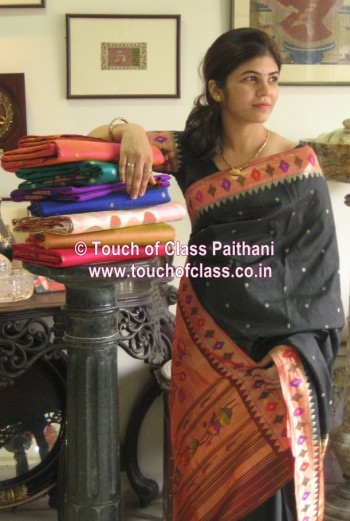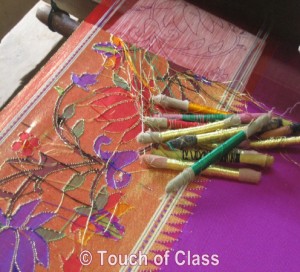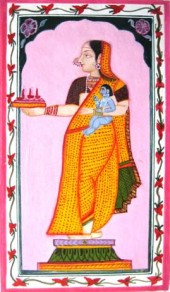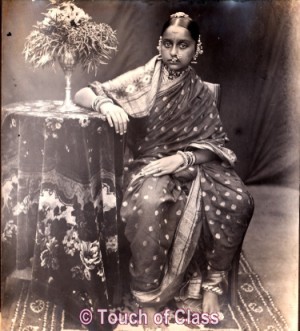
MEET Ms. RASHMI TAPADIA (FOUNDER-Touch of Class Paithani)
Journey So far:
Rashmi Tapadia is passionate about art and beauty that always driven her to know the techniques and feelings behind each creation she sees. Her education in Computer Engineering did not stop her to live a dream of becoming a designer by embarking on a own expedition. Her marriage with Dr. Prashant in 2003, who inherited legacy of art and collectibles of seven generations from his family that once served Princely States of Deccan as jewelers, changed her perspective of art. It was perfect union of legacy of art and art lover. Since then, Rashmi incorporated Maratha art in their conquest and specialized her research into Maratha (rather known as Deccani) art & history. She has traveled extensively to North America and Europe. Visits to invaluable collection of art and monuments underlined with the public interest, awareness and the glory each piece of art achieved made a deep impression on her. It also highlighted the distinction between the Indian approach towards the art. It was the negative feeling that so called developing nation is witnessing; demolished monuments, faking of the art and making profits using emotional keywords like tradition and culture without truly connecting to the history. Her return to India was eminent as it felt very deep in heart that she should share her experience and contribute something to connect people to the magnificent facets of Indian art. Her training in miniature paintings, watercolor, tapestry weaving, and ability to understand the art gave her strong foundation to march on to this path.

In 2006, she returned from United States with higher studies, her first visit to Yeola and Paithan shadowed with news that many Paithani looms were for sale due to challenges posed by machine-made ones. Local dealers who built empires from weavers sweat turned them down when they saw significant profits in machine made paithanies and fancy modern fabric. Some of weavers who were associated for many generations were distressed and opted for alternative work such as construction/farm labor or helper, which gave them more security than weaving. At that haste moment, Touch of Class has conceived. The first task was to bring back those who left and then save the rest. Challenge was to create an environment and opportunities to bring people once again choose Paithani and bring fair returns to weavers. Parallel and most difficult task was to create a support system for entire family of artisans such that in difficult times, they will remain faithful to this art of weaving. Today, Rashmi leads strong force of 75 artisans those are weaving future of most celebrated Indian art. It is her pride that with no external aid or funding, she has created a model of self-sustained system and dignity to each family.
Her venture is paying grandly with a range of clients she relies for support. Starting from top Indian corporate houses to art lovers around the world are joining her quest of revival. Serving over fourteen hundred strong clientele, Rashmi so far sold Paithani Sarees and Furnishings to over 40 countries cutting across origin and religion.

Expertise and Knowledge:
Rashmi studied every aspect of Paithani weaving, Maratha art and history, carrying a unique blend of knowledge of the past and present that forms a strong foundation for its revival and glorious future. Being part of every stage of process, from buying fine silk and precious metal to make Jari to the finished Paithani she not only monitors finest quality but it also allows her to experiment new ideas and innovations in designs. Her perspective and knowledge of various forms of art allows her to blend unique designs those are being highly appreciated by her clientele. Her role in upbringing quality of artisan’s life has earned assurance of revival at slower but sustainable pace. Rashmi also collected and sold many antique Paithani Sarees to art collectors around the world. She is currently writing a monograph “Paithani: Celebrated Indian Art” that portrays culture and tradition of this great Indian art.

Revival:
Revival in its literal meaning the efforts towards the art to be alive and practiced which in turn depends on the market force. Changing social concepts and generations demand different objects that are suitable for present times. Paithani remained synonym of a Saree for all along and thus lost track changing times. It retained its status of traditional wedding or celebration saree and lost the necessity of attire one may count for best appearance no matter what occasion is. Rashmi’s extensive research and travel around the world made her understand various outlooks of different generations and geographic locations those having their own expectations. New textiles ranging from cushion covers, stoles, curtains, tee-shirts, wall hangings, burkha’s and dress tops to laptop bags are being designed and weaved at her looms. This range of products in which the traditional art of Paithani weaving is being preserved while incorporating modern look and utility. Rashmi strongly believes that getting new generation and more variety into any traditional art is only way for its survival. Her endeavor has wholeheartedly welcomed by many corporate enterprises, hotels and private clientele and leading designer houses across India, North America and Europe.

Legacy of Paithani:
Paithani, popular by its name and unique art and tradition is carrier of legacy dating over 2000 years. Born in Paithan, the splendid capital of Satvahana Dynasty in 200 BC by the banks of divine Godavari River, under the patronage of Satvahana’s and later progressed throughout Deccan region. The ancient technique of tapestry has been practiced to make Paithanis, where multiple weft and warp threads of different colours along with gold and silver threads weaved together forming a fascinating piece of silk. At times, Romans imported this Golden Woven Fabric in exchange of gold of equal weight. Survived under changing rulers, art of Paithani flourished under Aurangzeb, who not only brought life to it but also incorporated many novelties in appearance. Floral motifs & AmarVell were contributions from Mughal era. Nizam of Hyderabad was most famous admirer of Paithanis. After declining Mughal influence, Peshwa of Pune once again took it under wings by settling weavers to Yeola, a small town near Shirdi, where Paithani took new dimensions in both design and popularity. Asawali, a motif of flowering vine has credited to Peshwa. Afterwards, Paithani remained ignored textile of Maharashtra in absence of real patronage until Government of India and Maharashtra state along with private enterprises took special interest in its revival. Once again, Paithani is becoming an iconic art of the India dissolving borders of geography and religion.
Paithani carrying cultural legacy of Maharashtra have special meaning in life of women who forms pillar of every family and society. It is the only textile, which unite entire elements of life in the form of blessings and protection to the wearer. Made from natural silk or cotton with precious metal of gold and silver, it gives the Midas touch. Particularly, the motifs that set Paithani above all other traditional fabric bear special significance of true Indian philosophy of living in harmony with nature and its elements.
